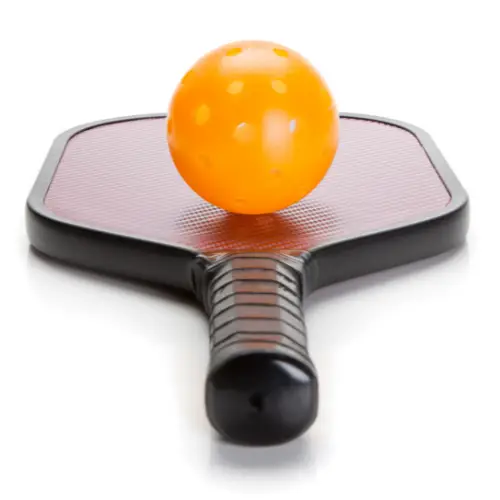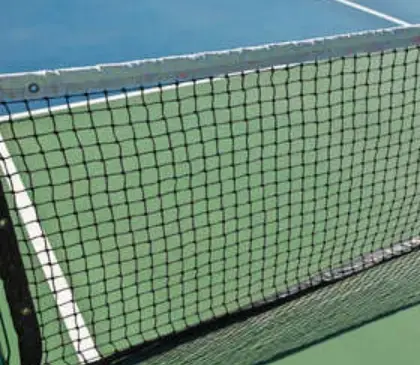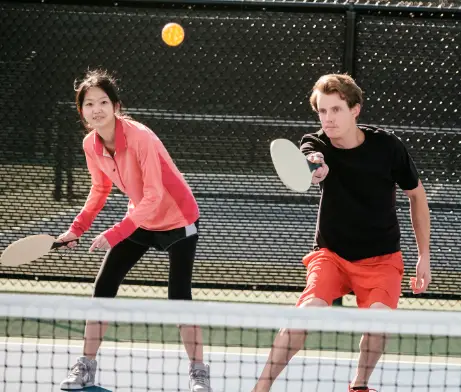Pickleball is a simple game, but it has some rules that can confuse beginners. The double bounce rule is one of those rules. This is also known as the 2-bounce rule and is even more confusing at first.
To make this rule easier to remember, you need to learn a few nitty-gritty details.
This double bounce starts with his two hits at the beginning of the game. This is accomplished by a serve and return of serve, with the ball bouncing after each of these two shots.
If the receiver and server bounce the ball once on each side, the double bounce rule is met and play is either a volley (shot from the air) or a groundstroke (ball bounces in front of the shot) will resume.
What Is The Purpose Of The Double Bounce Rule?
Pickleball was built around rallying to make the game more fun for everyone. This would not be possible without the double-bounce rule.
If the serve and service return can be played quickly (without bouncing), the point can be over in just a few strokes. A weak serve or return of serve can be used to score easy points in the kitchen.
Pickleball isn’t much fun when you only have two shots per point. Rallying is a great experience in any racquet sport. Pickleball’s double bounce rule amplifies this beautifully.
What Is The Reasoning Behind the Double Bounce Rule?
With this basic rule, pickleball friends can enjoy the longer rallies of this great game, unlike the game of ping-pong and tennis where the double bounce rule does not apply.
It prevents the server and the server’s partner from crashing the net immediately after the service which would put them in an extremely advantageous position to end the point quickly. Especially if the server has an exceptionally good service that would lead to frequent weak returns of servers.
This is counter to tennis and most other racquet sports where the serving team is permitted to crash the net immediately after the serve.
So, the double bounce rule:
- Somewhat evens the competition level
- It prevents the serving and returning team from being extremely aggressive on the first two shots of a point.
Who Benefits From The Double Bounce Rule?
As mentioned earlier, having members of the serving team wait for the return of the service will quickly prevent them from reaching the net. After the returning team has scored, you can rush to the kitchen.
The serving team must bounce the ball before it can be hit again. They effectively have a one-shot delay before they can charge the web.
This rule robs tennis players of a huge advantage used by legends like Pete Sampras and John McEnroe. These Hall of Farmers threw devastating serves at their opponents and sprinted for the net to score points.
Pickleball is a game where sneaky serves and, more importantly, the double bounce rule give no advantage to the serving team. This is one of our favorites of him. Unique among other paddle sports.
Since pickleball is a game of hidden serves, it is rarely returned. When a server returns a serve, it cannot reach the no-volley zone unless it returns very deep. There is no Pete Sampras two-shot winner. The conditions are the same for pickleball.
In fact, it could be argued that this rule gives the return-of-serve team a slight advantage by reaching the net first. It’s a game. So whoever gets there first has a slight advantage. This prevents the serving player or team from earning points.
What Are Ways To Mastering The Double Bounce Rule?
- Single Game – Returning Side
The first and easiest way to learn this rule is to start by standing behind the baseline when the serving team expects to serve. A few feet back may be needed if the server regularly hits the serve low.
Standing at the back of the field like this reduces the temptation to steal the ball before impact.
To get a strategic advantage on points, you need to push toward the net immediately after the return of the serve (only hit after the rebound).
- Single Game – Server Side
2 bounces his rule is a returner because in other sports the first bounce part of the rule is common but his second bounce part of the rule is not It’s more of a problem for the server than
You must stay behind the baseline after serving so that the ball bounces in front of you after the receiver returns.
What this means is that if you can hit a return near the baseline, you don’t want to go on the court because you risk getting stuck in a bad spot. Dealing with an impact from behind is so problematic that you may not be able to fire that shot.
- Doubles Game Tip
Both players on the serving team start behind the baseline to allow space for the second bounce of his rule. Both the server and the server’s partner are more prone to getting caught up in the rules than the server, so the server’s partner needs to help signal starting points behind the baseline.
The receiver’s partner is the only player on the field who can volley the first shot because he can start from the no-volley zone line and can only hit the 4th shot of the point as the first shot to the point. You should take advantage of this by appearing in court right from the start of the game.
The two-bounce rule is more likely to be a problem for the serving team than rebounding his team, as the serving team is responsible for his second ball, so you can use that as you please up to the fifth ball. You can’t be aggressive at this point. Get shot.
Conclusion
The purpose of the double bounce rule is to provide a smooth transition into the downturn and recovery phases of the game. More on this is below. Note that this rule does not mean that he can bounce the ball twice on his side of the field. As you know, if you let the ball bounce on his side twice, you lose the point immediately. This rule simply means that the ball must bounce once on both sides for the service and return. The bounce must occur on both sides of the court, hence the name double bounce rule.







